Citrus
Find information here for the top three citrus fruits in foodservice: lemons, limes and oranges.
Page contents:
Lemons | Lemon Sizing and Pack Count | Lemon Grading | Lemon Storage and Handling
Limes | Lime Sizing and Pack Count | Lime Grading | Lime Storage and Handling
Oranges | Orange Sizing and Pack Count | Orange Grading | Orange Storage and Handling
Popular Lemon Varieties
| Variety | Primary Applications and Attributes |
|---|---|
| Lemons: While there are several varieties of typical lemons, they are virtually indistinguishable |
|
| Meyer |
|
Lemon Sizing and Pack Count
| Size | Description | Case Net Weight | Serving Information | Average Diameter |
|---|---|---|---|---|
| 115 ct. | Lemons, Fresh Domestic/Imported | 35-40 lbs. | 5.57 oz. Avg. Each | 2.410" |
| 140 ct. | Lemons, Fresh Domestic/Imported | 35-40 lbs. | 4.57 oz. Avg. Each | 2.240" |
| 165 ct. | Lemons, Fresh Domestic/Imported | 35-40 lbs. | 3.88 oz. Avg. Each | 2.130" |
| 200 ct. | Lemons, Fresh Domestic/Imported | 35-40 lbs. | 3.20 oz. Avg. Each | 2.010" |
| 235 ct. | Lemons, Fresh Domestic/Imported | 35-40 lbs. | -- | 1.880" |
Notes:
- Traditionally, sizing designation for citrus is determined by how many uniformly, sized items would fit in a traditional carton
- Today, the numbers seen in the product description refer to the size, rather than how they are packed
- Lemons are typically referenced by the lemon count
- Case weights typically range from 35-40 lbs., but smaller pack sizes may be available
- A lemon at room temperature will yield more juice than a cold lemon, but cold lemons yield the most zest
- One case of 115/140 count lemons equals 21 cups of fresh juice. One lemon equals 3 tbsp. grated peel
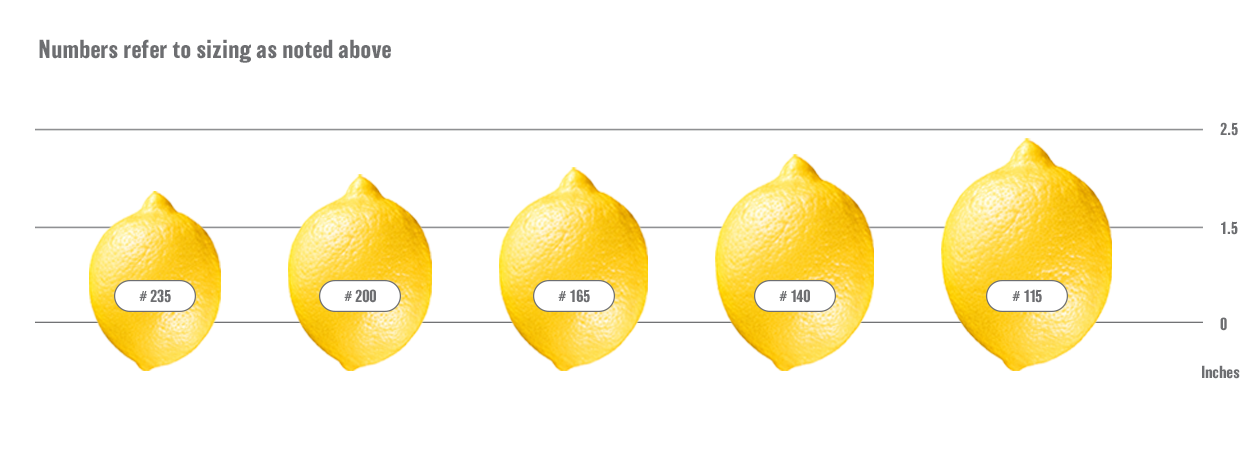
Lemon Grading
U.S. NO. 1 LEMONS MUST MEET THE FOLLOWING REQUIREMENTS:
- Mature, firm, fairly well formed, fairly smooth and fairly well colored
- Free from decay, contact spots, internal evidence of Alternaria development, unhealed broken skin, hard or dry skin, exanthema, growth cracks, internal decline (endoxerosis), red blotches and membranous stains or other internal discoloration
- Free from damage caused by bruises, dry or mushy condition, scars, oil spots, scale, sunburn, hollow core, peteca, scab, skin breakdown, melanose, dirt or other foreign material, other diseases, insects or other means
U.S. EXPORT NO. 1 LEMONS MUST MEET THE FOLLOWING REQUIREMENTS:
- Mature, firm, fairly well formed, fairly smooth and moderately well colored
- Free from decay, contact spots, internal evidence of Alternaria development, unhealed broken skins exanthema, growth cracks and internal discoloration
- Free from damage caused by bruises and dryness or mushy condition
- At least 50 percent of the lemons are free from damage caused by scars, oil spots, scale, sunburn, peteca, scabs, skin breakdown, melanose, dirt or other foreign material, other diseases, insects or other means, and the remainder of the lemons are free from serious damage by any cause
U.S. COMBINATION LEMONS MUST MEET THE FOLLOWING REQUIREMENTS:
- Consists of a combination of U.S. No. 1 and U.S. No. 2 lemons, provided that at least 40 percent, by count, of the lemons in each lot meet the U.S. No. 1 grade requirements
- Fairly well colored
U.S. NO. 2 LEMONS MUST MEET THE FOLLOWING REQUIREMENTS:
- Mature, fairly firm, reasonably well formed, reasonably smooth and fairly well colored
- Free from decay, contact spots, internal evidence of Alternaria development, unhealed broken skin, hard or dry skin, exanthema, internal decline (endoxerosis), and red blotch
- Free from serious damage caused by bruises, membranous stains or other internal discoloration, dryness or mushy condition, scars, oil spots, scale, sunburn, hollow core, peteca, growth cracks, scabs, skin breakdown, melanose, dirt or other foreign material, other diseases, insects or other means
Lemon Storage and Handling
- Maintain adequate air ventilation during storage
- Keep cartons off the floor to help prevent dampening of boxes from condensation of moisture in the room and for food safety
- Store lemons away from foods with strong odors and ethylene-producing fruits
- Ideal storage temperature: 45 - 50°F in the red zone of the cooler
- To preserve the fresh appearance of lemon wedges after they are prepared, refrigerate in covered containers
Popular Lime Varieties
| Variety | Primary Applications and Attributes |
|---|---|
| Limes: While there are several varieties of typical limes, they are virtually indistinguishable | 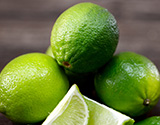 Elongated to round shape, with thin, smooth, shiny skin. Typically sold while still dark green; gradually turns light green when ripened. Internal segments are light pale green in color and have few seeds, if any. Distinctive piney, floral flavor and spicy aroma notes. Use lime wedges, cartwheels and twists in cocktails and other beverages. Add freshly squeezed lime juice to stir-fry or guacamole. Add lime zest to butter, plain vegetables, grilled meat, fish and poultry. Elongated to round shape, with thin, smooth, shiny skin. Typically sold while still dark green; gradually turns light green when ripened. Internal segments are light pale green in color and have few seeds, if any. Distinctive piney, floral flavor and spicy aroma notes. Use lime wedges, cartwheels and twists in cocktails and other beverages. Add freshly squeezed lime juice to stir-fry or guacamole. Add lime zest to butter, plain vegetables, grilled meat, fish and poultry. |
| Key Lime | 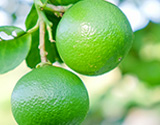 Very small, round, flavorful limes. Thin, leathery-skinned fruit that ranges in color from light green to yellow, with yellow flesh. Typically heavy (in weight) for size, indicating high juice content. Can add a tart–sweet flavor to sherbets, freezer cakes, fruit punch and other beverages or cocktails. Use citrus zest to enhance salads, breads, soups, vegetables, relishes, salsas and sauces, or in Key Lime Pie. Very small, round, flavorful limes. Thin, leathery-skinned fruit that ranges in color from light green to yellow, with yellow flesh. Typically heavy (in weight) for size, indicating high juice content. Can add a tart–sweet flavor to sherbets, freezer cakes, fruit punch and other beverages or cocktails. Use citrus zest to enhance salads, breads, soups, vegetables, relishes, salsas and sauces, or in Key Lime Pie. |
Lime Sizing and Pack Count
| Size | Description | Case Net Weight | Serving Information | Average Diameter |
|---|---|---|---|---|
| 110 ct. | Limes, Fresh Domestic/Imported | 35-40 lbs. | 5.82 oz. Avg. Each | 2.625" |
| 150 ct. | Limes, Fresh Domestic/Imported | 35-40 lbs. | 4.27 oz. Avg. Each | 2.375" |
| 175 ct. | Limes, Fresh Domestic/Imported | 35-40 lbs. | 3.66 oz. Avg. Each | 2.25" |
| 200 ct. | Limes, Fresh Domestic/Imported | 35-40 lbs. | 3.20 oz. Avg. Each | 2.00" |
| 225 ct. | Limes, Fresh Domestic/Imported | 35-40 lbs. | 2.84 oz. Avg. Each | -- |
| 230 ct. | Limes, Fresh Domestic/Imported | 35-40 lbs. | -- | 1.938" |
| 250 ct. | Limes, Fresh Domestic/Imported | 35-40 lbs. | -- | 1.875" |
Notes: Let limes warm up to room temperature for a hour before squeezing them, to maximize juice yield.
- Traditionally, sizing designation for citrus was determined by how many uniformly sized items would fit in a traditional carton
- Today, the numbers seen in the product description refer to the size, rather than how they are packed
- Limes are typically referenced by the count
- Case weights typically range from 35-40 lbs., but smaller pack sizes may be available
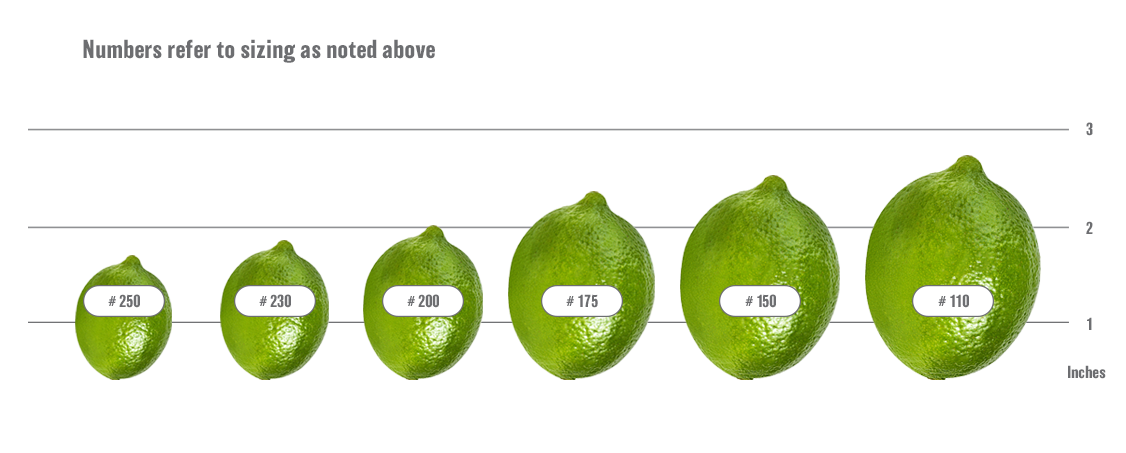
Lime Grading
U.S. NO. 1 PERSIAN LIMES MUST MEET THE FOLLOWING REQUIREMENTS:
- Firm, fairly well formed and of fairly smooth texture
- Free from decay, stylar end breakdown or other internal discoloration, broken skins which are not healed, bruises (except those incident to proper handling and packing) and hard or dry skin
- Free from damage caused by freezing, dryness or mushy condition, spray burn, exanthema (ammonization), scars, thorn scratches, scale, sunburn, scabs, blanching, yellow color, discoloration, buckskin, dirt or other foreign material, disease, insects or mechanical equipment or other means
- Has a juice content of no less than 42 percent, by volume or weight
- Color: Each fruit does not have less than an aggregate area of three-fourths of the surface of the fruit, which shows good green color characteristic of the Persian lime
- Many limes which fail to meet the U.S. No. 1 grade requirements only because of blanching may be designated as “U.S. No. 1, Mixed Color”
- Many limes which fail to meet the U.S. No. 1 or U.S. No. 1 Mixed Color grade requirements only because of turning yellow or yellow color, caused by the ripening process, may be designated as “U.S. No. 1, Turning”
U.S. COMBINATION PERSIAN LIMES MUST MEET THE FOLLOWING REQUIREMENTS:
- Consists of a combination of U.S. No. 1 and U.S. No. 2 limes, provided that at least 60 percent, by count, of the limes in the lot meet the U.S. No. 1 grade requirements
- The U.S. No. 1 limes shall meet the color requirements of the U.S. No. 1 grade, and the U.S. No. 2 limes shall meet the color requirements of the U.S. No. 2 grade
- Many limes which fail to meet the U.S. Combination grade requirements because of blanching may be designated as “U.S. Combination, Mixed Color”
- Many limes which fail to meet the U.S. Combination or U.S. Combination Mixed Color grade requirements because of turning yellow or yellowish color, caused by the ripening process, may be designated as “U.S. Combination, Turning”
U.S. NO. 2 PERSIAN LIMES MUST MEET THE FOLLOWING REQUIREMENTS:
- Fairly firm, not badly deformed and not of excessively rough texture
- Free from decay, stylar end breakdown or other internal discoloration, broken skin which are not healed, bruises (except those incident to proper handling and packing) and hard or dry skin
- Free from serious damage caused by freezing, dryness or mushy condition, spray burn, exanthema (ammonization), scars, thorn scratches, scale, sunburn, scabs, blanching, yellow color, discoloration, buckskin, dirt or other foreign material, diseases, insects or mechanical equipment or other means
- Has a juice content of no less than 42 percent, by volume or weight
- Color: Each fruit in this grade shall have not less than an aggregate area of one-half of the surface of the fruit, which shows good green color characteristic of the Persian lime
- Many limes which fail to meet the U.S. No. 2 grade requirements because of blanching may be designated as “U.S. No. 2, Mixed Color”
- Many limes which fail to meet the U.S. No. 2 or U.S. No. 2 Mixed Color grade requirements because of turning yellow or yellowish color, caused by the ripening process, may be designated as “U.S. No. 2, Turning”
Lime Storage and Handling
- Store limes in a well-ventilated area and away from direct sunlight
- Keep cartons off the floor to prevent boxes from becoming damp, and for food safety
- Handle limes with care to avoid bruising and internal decay
- Ideal storage temperature; 52 - 58°F in the black zone of the cooler
POPULAR Orange VARIETIES
| Variety | Primary Applications and Attributes |
|---|---|
| Cara Cara | 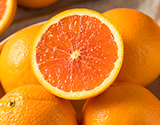 Outward appearance is similar to other navels, but interior is a distinctive pinkish red, due to natural presence of Lycopene. Flavor resembles a rich, orange taste. Has an exceptionally sweet flavor with a tangy cranberry-like zing, with overtones of raspberries and strawberries. Cara Cara oranges may be eaten on their own or added to fruit salads or juices. Outward appearance is similar to other navels, but interior is a distinctive pinkish red, due to natural presence of Lycopene. Flavor resembles a rich, orange taste. Has an exceptionally sweet flavor with a tangy cranberry-like zing, with overtones of raspberries and strawberries. Cara Cara oranges may be eaten on their own or added to fruit salads or juices. |
| Moro Blood | 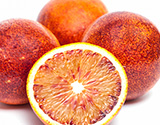 Small- to medium-sized, with a thin skin and few or no seeds. Outside appearance is typical of an orange, but inner flesh is a dramatic bright red to deep maroon. Flavor is less acidic than a typical orange - with light raspberry notes. Moro Blood oranges may be eaten on their own, segmented and added to salads, salsas and chutneys, or roasted or grilled with meat and poultry. Small- to medium-sized, with a thin skin and few or no seeds. Outside appearance is typical of an orange, but inner flesh is a dramatic bright red to deep maroon. Flavor is less acidic than a typical orange - with light raspberry notes. Moro Blood oranges may be eaten on their own, segmented and added to salads, salsas and chutneys, or roasted or grilled with meat and poultry. |
| Navel or Valencia | 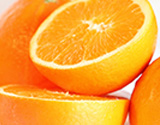 Slightly thick skin, few or no seeds, easy to peel and separate the fruit along the natural divisions. Floral aroma sweet and juicy. Has an exceptionally sweet flavor with a tangy cranberry-like zing, with overtones of raspberries and strawberries. Oranges can be sectioned and added to cereal, pancakes or waffles, yogurt or dipped in chocolate for a unique dessert or sliced and added to salads. Orange skins can be made into candied peels or used in preserves, while juice and zest is great for marinades. Slightly thick skin, few or no seeds, easy to peel and separate the fruit along the natural divisions. Floral aroma sweet and juicy. Has an exceptionally sweet flavor with a tangy cranberry-like zing, with overtones of raspberries and strawberries. Oranges can be sectioned and added to cereal, pancakes or waffles, yogurt or dipped in chocolate for a unique dessert or sliced and added to salads. Orange skins can be made into candied peels or used in preserves, while juice and zest is great for marinades. |
| Satsuma Mandarin |  Peels and segments easily. Light orange color exterior, bright orange interior, with few seeds. Flavor is less acidic than a typical orange with light raspberry notes. Peels and segments easily. Light orange color exterior, bright orange interior, with few seeds. Flavor is less acidic than a typical orange with light raspberry notes. |
| Clementines | 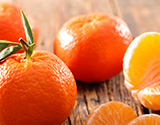 The Clementine is the smallest of the mandarin oranges. Unlike the tangerine, it's seedless. If a Clementine does have seeds, its typically evidence that bees have cross - pollinated the trees with other fruit, so Clementine trees are typically segregated in an attempt to keep the fruit seedless. Slightly flattened sphere and around 2 inches in diameter. Relatively small in size, which increases the price for larger-sized Clementines. Glossy, deep orange peel is loose, making it very easy to peel. The Clementine is the smallest of the mandarin oranges. Unlike the tangerine, it's seedless. If a Clementine does have seeds, its typically evidence that bees have cross - pollinated the trees with other fruit, so Clementine trees are typically segregated in an attempt to keep the fruit seedless. Slightly flattened sphere and around 2 inches in diameter. Relatively small in size, which increases the price for larger-sized Clementines. Glossy, deep orange peel is loose, making it very easy to peel. |
Orange Sizing and Pack Count
| Size | Description | Case Net Weight | Serving Information | Average Diameter |
|---|---|---|---|---|
| 48 ct. | Oranges, Fresh Domestic/Imported | 35-40 lbs. | 13.3 oz. Each | 3.47" |
| 56 ct. | Oranges, Fresh Domestic/Imported | 35-40 lbs. | -- | 3.30" |
| 72 ct. | Oranges, Fresh Domestic/Imported | 35-40 lbs. | 8.89 oz. Each | 3.04" |
| 88 ct. | Oranges, Fresh Domestic/Imported | 35-40 lbs. | 7.27 oz. Each | 2.84" |
| 113 ct. | Oranges, Fresh Domestic/Imported | 35-40 lbs. | 5.66 oz. Each | 2.60" |
| 138 ct. | Oranges, Fresh Domestic/Imported | 35-40 lbs. | 4.64 oz. Each | 2.42" |
| 163 ct. | Oranges, Fresh Domestic/Imported | 35-40 lbs. | 3.93 oz. Each | 2.29" |
Notes:
- Traditionally, sizing designation for citrus was determined by how many uniformly sized items would fit in a traditional carton
- Today, the numbers seen in the product description refer to the size, rather than how they are packed
- Oranges are typically referenced by the count. Oranges may be available as a range of sizes to be used specifically for juicing
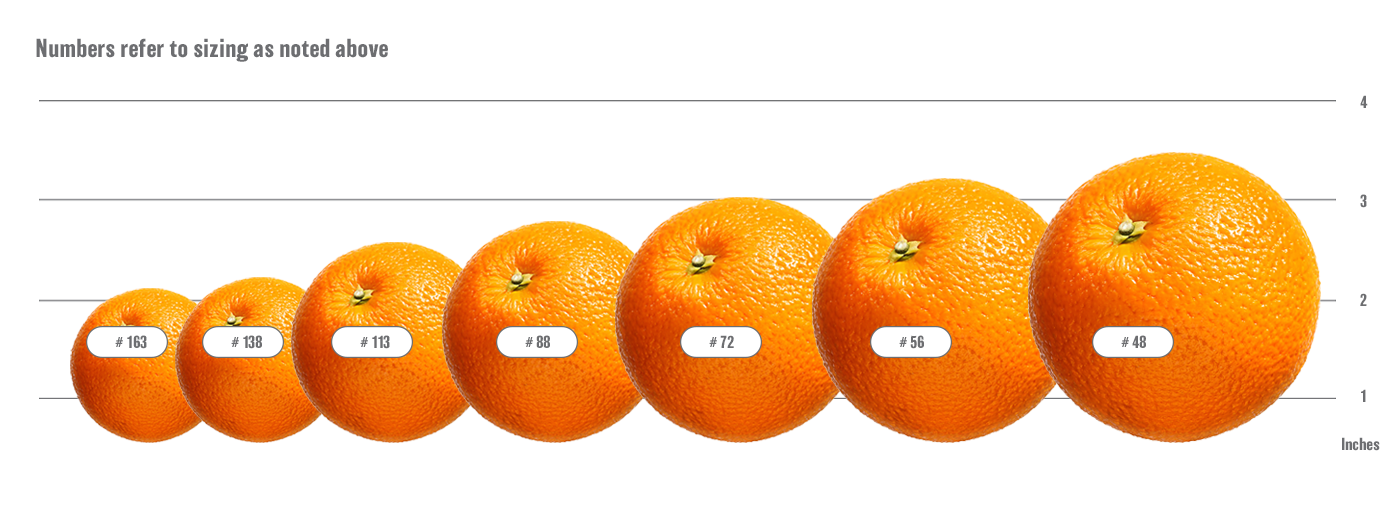
GRADES OF CALIFORNIA AND ARIZONA ORANGES
U.S. FANCY ORANGES MUST MEET THE FOLLOWING REQUIREMENTS:
- Similar varietal characteristics
- Mature, well colored, firm, well-formed and of smooth texture
- Free from decay, broken skins which are not healed, hard or dry skins, exanthema, growth cracks and dryness or mushy condition
- Free from injury caused by bruises; split, rough, wide or protruding navels; creasing; scar; oil spots; scale, skin breakdown; sunburn; dirt or other foreign material; diseases; insects or mechanical or other means
U.S. NO. 1 ORANGES MUST MEET THE FOLLOWING REQUIREMENTS:
- Similar varietal characteristics
- Mature, firm, well-formed and of fairly smooth texture
- Well colored, except Valencia oranges, which shall be at least fairly well colored
- Navel oranges in any lot which is destined for export, and which is certified as meeting the standards for export, need be only fairly well colored
- Free from decay, broken skins which are not healed, hard or dry skins, exanthema and growth cracks
- Free from damage caused by bruises, dryness or mushy condition, split, rough, wide or protruding navels, creasing, scars, oil spots, scale, skin breakdown, sunburn, dirt or other foreign material, diseases, insects or mechanical or other means
U.S. COMBINATION ORANGES MUST MEET THE FOLLOWING REQUIREMENTS:
- Consists of a combination of U.S. No. 1 and U.S. No. 2 oranges, provided that at least 40 percent, by count, of the oranges in each lot meet U.S. No. 1 grade requirements
U.S. NO. 2 ORANGES MUST MEET THE FOLLOWING REQUIREMENTS:
- Similar varietal characteristics
- Mature, fairly well colored, fairly firm, fairly well-formed and may be of slightly rough texture
- Free from decay, broken skins which are not healed, hard or dry skins, exanthema and growth cracks
- Free from serious damage caused by bruises, dryness or mushy condition, split or protruding navels, creasing, scars, oil spots, scale, skin breakdown, sunburn, dirt or other foreign material, diseases, insects or mechanical or other means
GRADES OF Florida ORANGES
U.S. FANCY ORANGES MUST MEET THE FOLLOWING REQUIREMENTS:
- Similar varietal characteristics
- Mature, firm, smooth texture, well colored and well-formed
- No more than one-tenth of the surface, in the aggregate, may be affected by discoloration
- Free from ammonization, buckskin, caked melanose, creasing, decay, scabs, split navels, spray burn, undeveloped segments, unhealed skin breaks and wormy fruit
- Free from injury caused by bruises; green spots; oil spots; rough, wide, or protruding navels; scale; scars; skin breakdown and thorn scratches
- Free from damage caused by dirt or other foreign material, diseases, dryness or mushy condition, hail, insects, riciness or woodiness, sunburn and other means
U.S. NO. 1 ORANGES MUST MEET THE FOLLOWING REQUIREMENTS:
- Similar varietal characteristics
- Mature, firm, well-formed, fairly smooth texture
- Color: Early and midseason varieties shall be fairly well colored. For Valencia and other late varieties, no less than 50 percent by count, shall be fairly well colored and the remainder reasonably well colored
- No more than one-third of the surface, in the aggregate, may be affected by discoloration
- Free from decay, unhealed skin breaks and wormy fruit
- Free from damage caused by ammonization; bruises; buckskin; caked melanose; creasing; dirt or other foreign material; diseases; dryness or mushy condition; green spots; hail; insects; oil spots; riciness or woodiness; scabs; scale; scars; skin breakdown; split, rough or protruding navels; spray burn; sunburn; thorn scratches and other means
U.S. NO. 2 ORANGES MUST MEET THE FOLLOWING REQUIREMENTS:
- Similar varietal characteristics
- Mature, fairly firm, not more than slightly misshapen and not more than slightly rough textured
- Reasonably well colored
- Not more than one-half of the surface, in the aggregate, may be affected by discoloration
- Free from decay, unhealed skin breaks and wormy fruit
- Free from serious damage caused by ammonization; bruises; buckskin; caked melanose; creasing; dirt or other foreign material; diseases; dryness or mushy condition; green spots; hail; insects; oil spots; riciness or woodiness; scabs; scale; scars; skin breakdown; split, rough or protruding navels; spray burn; sunburn; thorn scratches and other means
U.S. NO. 3 ORANGES MUST MEET THE FOLLOWING REQUIREMENTS:
- Similar varietal characteristics
- Mature, misshapen, rough texture, not seriously bumpy, slightly spongy and poorly colored
- Free from decay, unhealed skin breaks and wormy fruit
- Free from very serious damage caused by ammonization, bruises, buckskin, caked melanose, creasing, diseases, dryness or mushy condition, hail, insects, riciness or woodiness, scabs, scale, scars, skin breakdown, split navels, spray burn, sunburn and other means
GRADES OF TEXAS (AND STATES OTHER THAN FLORIDA, CALIFORNIA AND ARIZONA) ORANGES
U.S. FANCY ORANGES MUST MEET THE FOLLOWING REQUIREMENTS:
- Similar varietal characteristics
- Mature, firm, well colored, well-formed and smooth texture
- Not more than one-tenth of the surface, in the aggregate, may be affected by discoloration
- Free from ammonization, bruises, buckskin, caked melanose, creasing, cuts not healed, decay, growth cracks, scabs, skin breakdown, spray burn, undeveloped segments and wormy fruit
- Not injured by green spots; oil spots; split navels; rough, wide or protruding navels; scale scars; and thorn scratches
- Not damaged by any other cause
U.S. NO. 1 ORANGES MUST MEET THE FOLLOWING REQUIREMENTS:
- Similar varietal characteristics
- Mature, firm, well-formed and fairly smooth texture
- Color: Early and midseason varieties shall be fairly well colored
- For Valencia and other late varieties, not less than 50 percent, by count, shall be fairly well colored and the remainder reasonably well colored
- Free from bruises, cuts not healed, caked melanose, decay, growth cracks, spray burn, undeveloped segments and wormy fruit
U.S. NO. 2 ORANGES MUST MEET THE FOLLOWING REQUIREMENTS:
- Similar varietal characteristics
- Mature, fairly firm, reasonably well colored, not more than slightly misshapen and not more than slightly rough
- Not more than one-half of the surface, in the aggregate, may be affected by discoloration
- Free from bruises, unhealed cuts, decay, growth cracks and wormy fruit
- Not seriously damaged by any other cause
U.S. NO. 3 ORANGES MUST MEET THE FOLLOWING REQUIREMENTS:
- Similar varietal characteristics
- Mature and not seriously lumpy or cracked
- May be misshapen, slightly spongy, have rough texture and poorly colored
- Not more than 25 percent of the surface may be of a solid dark green color
- Free from unhealed cuts, decay and wormy fruit
- Not very seriously damaged by any other cause
Orange Storage and Handling
- Store oranges in a well-ventilated area; keep cartons off the floor to prevent boxes from becoming damp
- Keep oranges separated from foods that absorb odors – such as eggs, apples, cheese or butter
- Oranges are typically stored closest to the cooler door in the red zone of the cooler


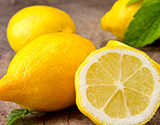 Knobby, firm, medium-thick, bright yellow skin, neck may be short to non-existent at the stem end, while the blossom end may be knob-shaped or tapered to a slight point. Has some seeds; a yellow, juicy flesh; a very tart juice; and a fragrant, oily peel. Use zest and juice to accent salads, beverages or cocktails, baked goods, poultry, seafood or in marinades as a natural tenderizer.
Knobby, firm, medium-thick, bright yellow skin, neck may be short to non-existent at the stem end, while the blossom end may be knob-shaped or tapered to a slight point. Has some seeds; a yellow, juicy flesh; a very tart juice; and a fragrant, oily peel. Use zest and juice to accent salads, beverages or cocktails, baked goods, poultry, seafood or in marinades as a natural tenderizer.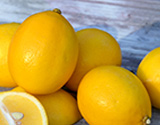 Cross between a lemon and a sweet orange. Rich, yellow orange in color and sweeter than typical lemons, with hints of orange flavoring. Peels are often thinner than traditional lemons and require care if zesting. Use in place of regular lemon juice in cocktails, or add Meyer lemons in chutneys, fruit salads and desserts, such as sorbet. When substituting for regular lemons in recipes with added sugar, consider reducing the amount of added sugar, since Meyer lemons are sweeter.
Cross between a lemon and a sweet orange. Rich, yellow orange in color and sweeter than typical lemons, with hints of orange flavoring. Peels are often thinner than traditional lemons and require care if zesting. Use in place of regular lemon juice in cocktails, or add Meyer lemons in chutneys, fruit salads and desserts, such as sorbet. When substituting for regular lemons in recipes with added sugar, consider reducing the amount of added sugar, since Meyer lemons are sweeter.